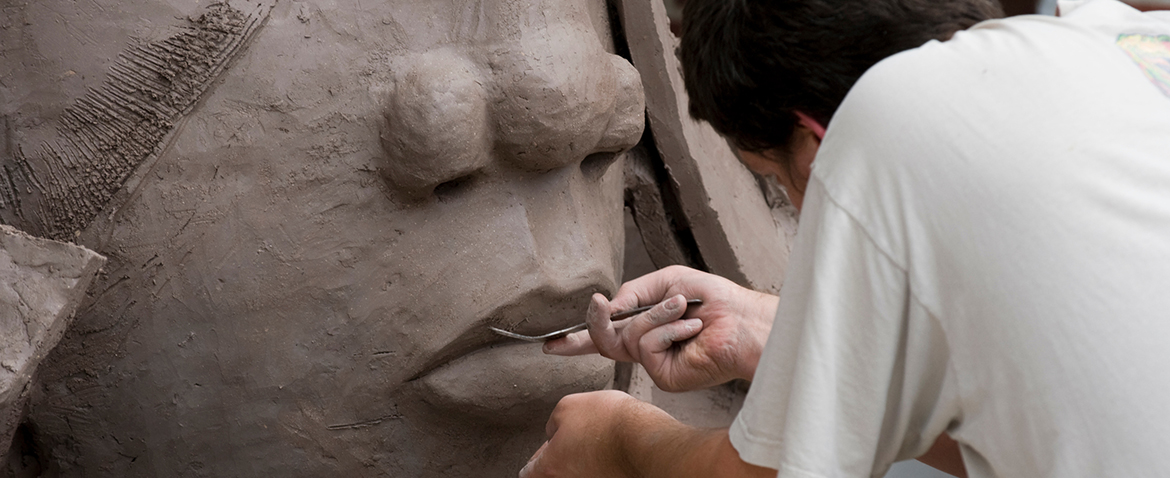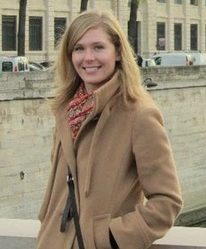Art History is more than analyzing art—it broadens our worldviews, develops global understanding, and cultivates cultural sensitivity through close engagement with the rich history of artworks, practices and material culture across time and space.
The UNCG Art History concentration within the BA Art degree is an object-focused program offering students global, historical and contemporary perspectives on art through coursework and hands-on experiences both locally and abroad. Through their training in cross-cultural and transhistorical critical analysis of the visual world, majors will take their place as informed global citizens prepared for life-long critical engagement and a wide variety of scholarly pursuits.
Graduates of this versatile program are well equipped to meet the demands of the 21st Century. Majors have joined competitive graduate schools and built careers in a wide range of professions from museum curators to art librarians, university professors to lawyers, and government service to social media executives.
Resources
COURSE OF STUDY
Art history classes develop the core skills of close looking, writing, research, creative and analytical thinking, visual literacy and effective communication. Courses take the form of lectures, internships, independent studies, seminars and on-site investigations in museums, archives, and even Renaissance churches and palaces. Small, major specific classes, such as the topical Sophomore Seminar in Art History (ARH 219) and the advanced Research Topics in Art (ARH 405) provide students with one-on-one experiences with the area’s dynamic faculty.
Students shape their own degree by selecting a minor and a foreign language that complement their future careers paths. Past majors have selected from a range of subjects in which to minor including Classical Studies, History, Religious Studies, Anthropology, English, Media Studies, Political Science, and Women, Gender, and Sexuality Studies, among others.
PROGRAM DISTINCTIONS
The Art History program is distinguished by the breadth, quality and diverse research conducted by its award-winning faculty. From contemporary South African pottery to Italian Renaissance portraiture, to performance by contemporary Latinx and Afro-Latinx artists, to histories of photography and Native American art in the Atlantic World, to the art and artists of the Disney and Pixar Animation Studios, innovative faculty research informs every course taught in this program.
Here, faculty and students co-lead meaningful and community-engaged projects based in art historical research, such as increasing the accessibility of public art in Greensboro. Working closely with faculty, students develop their own critical voices in a range of high-impact, public-facing research projects such as making historically underrepresented artists visible through new Wikipedia pages, social media takeovers and essays published on museum websites, as well as critical reviews of art exhibitions in national publications.
In person, student engagement with works of art is a core value. This priority has led Art History faculty to actively engage students with the collections and exhibitions of the nationally-renowned Weatherspoon Art Museum on UNCG’s campus in their courses, develop student programs with the Greensboro Project Space in downtown Greensboro, and lead student field trips to other art institutions across the state including the North Carolina Museum of Art in Raleigh and the Mint Museum in Charlotte and abroad in the Uffizi and the Accademia dell’ Arte of Florence, Italy.
THE STUDENT EXPERIENCE.
With the guidance and mentorship of area faculty, majors often present their work at local and regional undergraduate conferences and symposia. Majors have presented at the UNCG Undergraduate Research and Creativity Expo, State of North Carolina Undergraduate Research and Creativity Symposium, and National Conference on Undergraduate Research. Graduates have published their research in Explorations: The Journal of Undergraduate Research Activities for the State of North Carolina and co-authored work with faculty members for scholarly publications.
Our faculty have been strong supporters of the McNair Scholars Program, “a federal TRiO program funded by the U.S. Department of Education. Designed to prepare undergraduate students for the pursuit of a Ph.D” who come from first-generation and under-represented backgrounds. Our graduates have pursued degrees at highly-prestigious graduate programs. https://success.uncg.edu/departments/opportunity-programs/trio/uncg-mcnair-scholars-program/
Every other summer, School of Art faculty lead an immersive, four-week study abroad trip to Florence, Italy. Focused on the art history of the Italian Renaissance and taught on-site, the program offers attending art history majors the opportunity to earn six credit hours of art history, all while living, studying and experiencing Italy firsthand.
Students may choose to participate in a range of university clubs and activities, including Co-WAM, the student organization of the Weatherspoon Art Museum on UNCG’s campus. Majors interested in museum work frequently hold summer internships at local institutions such as The Weatherspoon Art Museum, The Reynolda House Museum of American Art, The North Carolina Museum of Art and the Mint Museum.
Students interested in Disciplinary Honors in Art History may pursue a focused course of advanced study that involves independent learning and student-faculty mentorship through a collaboration with the School of Art and Lloyd International Honors College. Many majors earn invitations to our nation’s most prestigious Honors Societies including, Phi Beta Kappa and Phi Kappa Phi.
Art History Faculty
The Annual Carolyn & Norwood Thomas Undergraduate Research and Creativity Expo
2014 2nd Place in the Humanities—Eliana Mundula
Faculty Mentor- Heather Holian, Art History
“Learned, Mannered, and Titled: Baccio Bandinelli’s Self-Referential Work in the Context of the Changing Status of the Artist”
2013 1st Place in the Humanities–Mary Piepmeier
Faculty Mentor – Heather Holian, Art History
“The Medici Gardens: Microcosms of Divine Rule”
2013 2nd Place in the Humanities—Steisha Pintado, BFA painting
Faculty Mentor – Heather Holian, Art History
“Remediated Optical Toys and the Animated GIF”
2013 Honorable Mention in Humanities — Michelle Lanteri
Faculty Mentor – Elizabeth Perrill, Art History
“Earth Forms: The Boundless Art of Lonnie Vigil and Ansel Adams”
2012 1st Place in the Humanities—Mary Piepmeier
Faculty Mentor – Heather Holian, Art History
Faculty Mentor – Derek Krueger, Religious Studies
“The Pola Casket”
2014 Lloyd International Honors College Symposium
3rd Place in the Humanities and Fine Arts—Eliana A. Mundula
Faculty Mentor—Lawrence Jenkens, Art History
“The Production of Identity in the Roman Military, 2nd-3rd C. A.D.”
Student Excellence Award Winners, the most prestigious academic award at UNCG
Kendall Llewellyn (2018)
Camille Knudsen (2015)
Eliana Mundula (2013)
Olivia Kirby (2013)
Taylor Burton (2013)
Kayla Cavenaugh (2013)
Mary Piepmeier (2012)
Henry Hilston (2010)
Golden Chain Honor Society
Suzi Tisdell (2011)
Phi Beta Kappa Society (Honor Society)
Emily Leon
Camille Knudsen
Mary Piepmeier
Kathleen Hardin
Henry Hilston
Ryan Macon
After graduating from the University of North Carolina at Greensboro, I relocated to New York City to take a position at the Whitney Museum of American Art as a gallery assistant. In addition, I work with the World Science Festival as an office administrator. My alma mater taught me how to succeed by equipping me with the necessary tools to compete in a competitive job market. With a degree in art history, my professors continue to support me in my post graduation endeavors by staying in contact and notifying me of career opportunities. I am thankful for my alma mater! Once a Spartan, always a Spartan!
Michelle Lanteri
My focus in the Art History and Museum Studies program was modern and contemporary art, with a particular interest in Native American contemporary artists. As such, the art history professors taught me to use visual artworks as entry points for studying the in-flux social, economical, and political climates of geographic locales across the globe. While working closely with the art history faculty, I was encouraged to pursue graduate programs that offered a specialty in Native American Studies, particularly in the state of New Mexico. Through their expertise in the field, UNCG’s art history faculty provided me with practical advice and excellent training to transition from undergraduate research to an interdisciplinary Master of Arts Art History, Museum Studies, and Native American Studies curriculum at New Mexico State University.
Suzi Tisdell
The program at UNCG laid a solid foundation for my current MA studies in Italian Renaissance art at Florida State University. The variety, intensity, and rigor of the program provided an invaluable conceptual toolkit with which I can approach a number of topics both within and outside of my declared area of interest. The emphasis UNCG’s art history program places on the practical application of complex theory as well as the graduate-style seminars gave me an advantage in my current studies and I find myself relying on much of what I learned in the program even now as I work towards completing my graduate degree. Perhaps the thing that distinguishes the program even more than the scholastic rigor is the unwavering and incomparable support the entire faculty showed me during my studies. I consider myself quite lucky to have UNCG as the basis for my academic pursuits.
Erin Riggins
The education and experience I received from the Art History program at UNCG provided me with the arts foundation needed to succeed outside the classroom. I was given the opportunity to pursue valuable internships at the Art Department’s Gatewood Gallery and Greenhill Gallery in downtown Greensboro, where I was offered a permanent position after finishing my BA. I learned a great deal in graduate school style seminars taught by the UNCG Art History faculty, who are all experts in their respective fields of study. I also studied abroad in Italy, attending lectures on-site in some of the most famous Renaissance structures in the world. I feel very fortunate to have benefited from the Art History program at UNCG and encourage fellow students of Art and Art History to take full advantage of the opportunities it provides.
Caroline Binz
I graduated with a BFA in Sculpture in 2010 and a BA in Art History and Museum Studies in 2014. I’m a Conservation Assistant at the Colorado Art Restoration Services in Lakewood, Colorado. I conserve objects ranging from ceramic, wood, metal, leather and glass. My job merges my interests and I am directly involved with conserving pieces.
Catherine Burns
As part of the Art History and Museum Studies program at UNCG, I did an internship at the Bechtler Museum of Modern Art in Charlotte where I became very interested in Collections Management. I decided to pursue a Master’s Certificate in Museum Collections Management and Care from the George Washington University. Upon completing that program, I moved to New York to accept an internship at the Solomon R. Guggenheim Museum in Exhibition Management. Since moving to New York, I have held various jobs in Collections and Exhibition Management at the Morgan Library and Museum, the Guggenheim and the Deutsche Bank corporate art collection. I have worked in the Modern and Contemporary department at the Metropolitan Museum of Art since 2015. In my current role as Collections Specialist, I am primarily responsible for coordinating acquisitions and incoming loans. My job allows me to work directly with the art which is something I really enjoy. I am very grateful to my professors and advisers at UNCG for preparing me for a career in this field.
These are the courses required by the Art History concentration. For a suggested schedule of courses for Art History students, see the schedule at the bottom of this page. For more information on these and other available courses, see the UNCG course bulletin.
In addition to meeting the College of Arts & Sciences Liberal Education Requirements, the required courses in the Art Department to complete a BA in Art History consist of:
- ARH 110: Survey of Western Art: Prehistory Renaissance (GFA)
- ARH 111: Survey of Western Art: Renaissance Contemporary (GFA
- ARH 112: Survey of Non-Western Art (GFA, GN)
- ARH 219: Sophomore Seminar in Art History (WI)
- ARH 405: Research Topics in Art History (WI/SI)
Minimum of 15 semester hours in Art History courses above the 200 level.
Minimum of 6-7 semester hours of Studio Art selected from the following:
- ART 120: Drawing I or
- ART 140: Foundation Design I or
- ART 150: Three Dimensional Foundations I and
- One 200-level studio art course.
Courses in Art History 200 and above:
- ARH 200 History of Western Architecture
- ARH 210 Art of Disney and Pixar
- ARH 211 Art and the African-American Presence
- ARH 212 The Portrait: Image and Identity
- ARH 213 Classical Architecture and Classic
- ARH 214 History of Ceramics: Critical Perspectives
- ARH 215 History of Printmaking to Digital Imaging
- ARH 301: Greek Art
- ARH 302: Roman Art
- ARH 310: Early Medieval and Byzantine Art
- ARH 311: Medieval and Romanesque Art
- ARH 312: Gothic Art
- ARH 320: Italian Renaissance Art
- ARH 321: Early Italian Renaissance Art, 1300-1480
- ARH 322: Art of the Italian High Renaissance and Maniera, 1480-1600
- ARH 325: Northern Renaissance Art
- ARH 330: Baroque Art
- ARH 340: European Art in the Eighteenth Century
- ARH 345: European Art in the Nineteenth Century
- ARH 347: American Art
- ARH 350: History of Photography
- ARH 351: Architecture in the Twentieth Century
- ARH 352: Early Twentieth-Century Art
- ARH 353: Late Twentieth-Century Art
- ARH 370: African Art
- ARH 371: The TransAtlantic: Cross-Cultural Representations
- ARH 395: Florence and the Medici
- ARH 400: Special Problems, Art History and Criticism (Independent Study)
- ARH 401: Special Problems, Museums Studies (Internship)
- ARH 403: Art History Research Seminar
- ARH 493: Honors Work (Independent Study)
- ARH 500: Traditions of Art Criticism
- ARH 501: Topics in the History of Art
- ARH 502: Historiography and Methodology
This list outlines the schedule of courses recommended for majors in the Art History concentration. For more information on courses and requirements, see the UNCG course bulletin. For information on advising, see the Art Department’s page or contact the Department.
University Minimums: 122 Hours Required, 36 at or above the 300 level.
Department Minimums: 12 Hours at or above the 300 level in Art History
Freshman Year
Semester I
ARH 110 (GFA)
Art 120, 140, or 150
Foreign Language 101
2 GECs/CARs
Recommended 15 credit hours
Semester II
ARH 111, ARH 112
2 GECs/CARs
Foreign Language 102
Recommended 15 credit hours
Sophomore Year
Semester III
ARH 219 (WI)
3 GECs/CARs
Foreign Language 203
Recommended 15 credit hours
Semester IV
ARH at the 300 level
ART: Studio at 200 Level
Foreign Language 204
2 GECs/CARs)
Recommended 15 credit hours
Junior Year
Semester V
ARH at 300 Level
ARH elective or other elective*
3 GECs/CARs
Recommended 15 – 18 credit hours
Semester VI
ARH at the 300 Level
2 ARH electives or other elective*
2 GECs/CARs
Recommended 15 – 18 credit hours
Senior Year
Semester VII**
ARH at 300 Level
4 ARH elective or other elective*
Recommended 15 – 18 credit hours
Semester VIII***
ARH 405 (WI/SI)***
ARH at the 300 level
4 ARH electives or other electives *
Recommended 15 – 18 credit hours
* Suggested departments for non-Art History electives/minor study include: African American Studies, Anthropology, Archaeology, Classical Studies, English, German and Russian (including Chinese and Japanese Studies), History, Interior Architecture, Media Studies, Philosophy, Religious Studies, Romance Languages, Women and Gender Studies.
** This plan represents the minimum within the Art History concentration. Of course, you are encouraged to select additional courses.
*** Students may elect to take ARH 405 in their junior year with permission of instructor.



